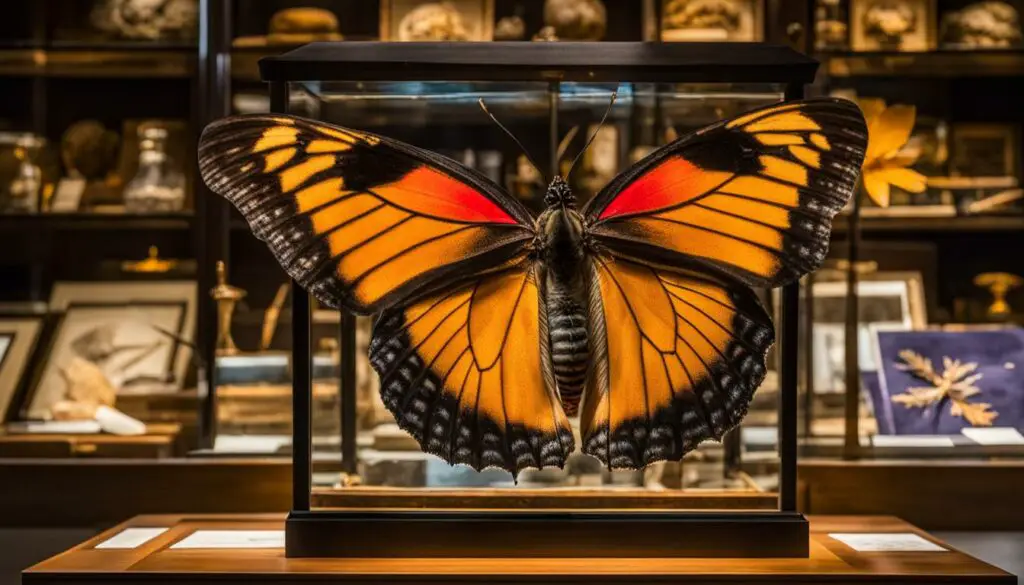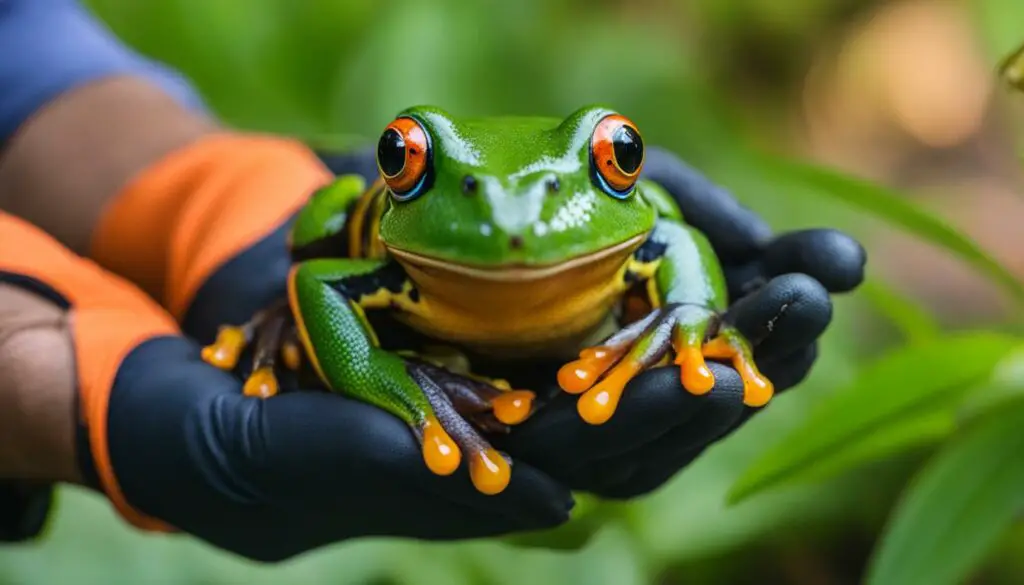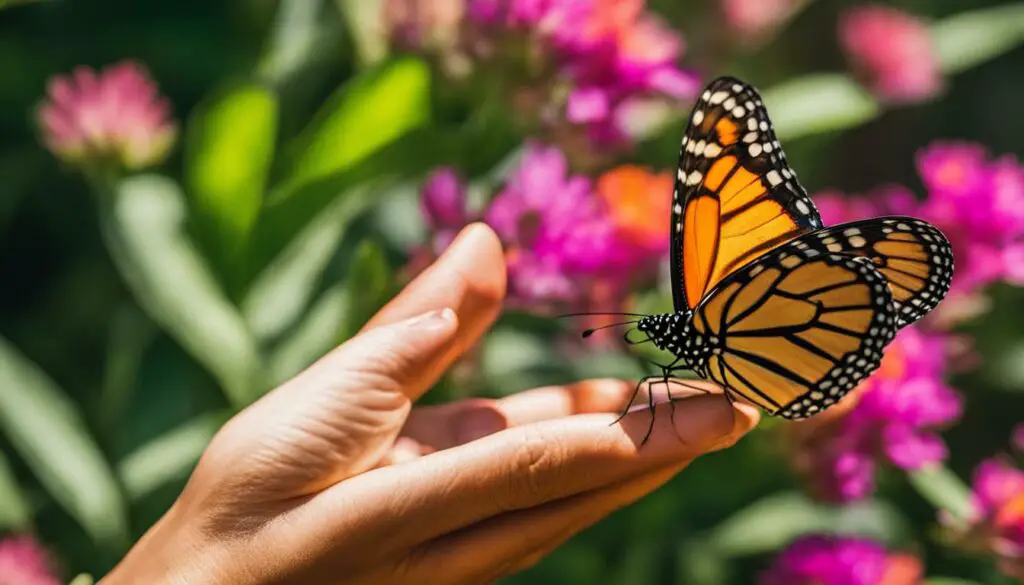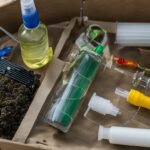If you’re fascinated by the delicate beauty of butterflies and want to learn how to interact with them safely, you’ve come to the right place. In this article, I will guide you through the techniques of gentle butterfly handling and conservation. With the right knowledge and approach, you can enjoy the enchanting world of butterflies while ensuring their well-being and preserving their beauty for generations to come.
Key Takeaways:
- Mastering the art of handling butterflies without harm is essential for their well-being.
- By using gentle techniques, you can interact with butterflies without damaging their delicate wings.
- Proper butterfly preservation tools and materials are crucial for safe handling and conservation.
- Ethical considerations play a vital role in butterfly taxidermy and preservation practices.
- Creating a dust-free and well-ventilated environment is necessary for displaying and caring for preserved butterflies.
The History of Butterfly Taxidermy
Butterfly taxidermy has a fascinating history that traces back to the Victorian era. During this time, collecting and preserving specimens became increasingly popular as a way to appreciate the intricate beauty of butterflies. The art of butterfly taxidermy involves carefully preserving and mounting butterflies to showcase their delicate features.
During the Victorian era, butterfly collecting became a popular hobby among nature enthusiasts. Explorers and collectors would venture into exotic locations to discover new species of butterflies. These specimens were then carefully preserved using various techniques to ensure their longevity and to capture their vibrant colors and intricate wing patterns.
Over the years, the techniques and tools used in butterfly taxidermy have evolved. In the past, butterflies were often killed by using toxic substances, such as cyanide, to immobilize them. However, modern practices focus on more humane methods that prioritize the conservation of butterfly populations. Ethical considerations have become an important aspect of butterfly taxidermy, with collectors now opting for sustainable practices and sourcing specimens in an ethical manner.

The Evolution of Butterfly Taxidermy
“The art of butterfly taxidermy has come a long way since its early days. Today, skilled taxidermists use expert techniques to preserve butterflies in a lifelike and beautiful manner.”
With advancements in technology and a greater understanding of butterfly preservation, the art of butterfly taxidermy has evolved significantly. Skilled taxidermists now use expert techniques to preserve butterflies in a lifelike and beautiful manner. Specialized tools, such as delicate tweezers and insect mounting strips, are used to carefully handle and position the butterflies during the preservation process.
Modern butterfly taxidermy also emphasizes the importance of proper specimen preparation and conservation. This includes using non-toxic substances for immobilizing butterflies, such as ethyl acetate, which is less harmful to the environment. Additionally, sustainable sourcing of specimens has become a priority, with many collectors focusing on breeding programs and obtaining specimens from ethical sources.
In conclusion, the history of butterfly taxidermy is a testament to our fascination with the beauty of these delicate creatures. From the Victorian era to the present day, the art has evolved, placing greater emphasis on ethical considerations and conservation. Skilled taxidermists continue to preserve the exquisite details of butterflies, allowing us to appreciate their beauty for generations to come.
Tools and Materials for Butterfly Preservation
Preserving butterflies requires the use of specific tools and materials to ensure their delicate wings remain intact. By using the right equipment, you can handle butterflies without causing any harm. Here is a list of essential tools and materials for butterfly preservation:
- Tweezers: A pair of fine-tipped tweezers is essential for gently holding and manipulating butterflies during the preservation process.
- Pins: Stainless steel insect pins are used to secure the butterfly onto a mounting board or spreading board.
- Mounting Boards: These specially designed boards provide a stable surface for arranging and spreading the butterfly’s wings.
- Spreading Boards: Spreading boards help maintain the butterfly’s wings in the correct position while they dry.
- Insect Mounting Strips: These adhesive strips are used to secure the butterfly onto the mounting board without damaging its delicate wings.
- Glassine Envelopes: These acid-free envelopes protect the preserved butterfly from dust and moisture.
| Tool/Material | Description |
|---|---|
| Tweezers | A pair of fine-tipped tweezers for handling butterflies gently. |
| Pins | Stainless steel pins for securing the butterfly onto a mounting board. |
| Mounting Boards | Specially designed boards for arranging and spreading the butterfly’s wings. |
| Spreading Boards | Boards that hold the butterfly’s wings in the correct position while they dry. |
| Insect Mounting Strips | Adhesive strips for securing the butterfly onto the mounting board. |
| Glassine Envelopes | Acid-free envelopes for protecting the preserved butterfly. |
These tools and materials can be easily found in specialty stores or online shops catering to entomology enthusiasts. It’s important to handle each item with care to ensure their longevity and effectiveness for butterfly preservation. With the right tools and materials, you can preserve butterflies and admire their beauty for years to come.
Step-by-Step Guide to Preserving Butterflies
Preserving butterflies is a delicate process that requires careful attention to detail. By following these step-by-step instructions, you can ensure that your preserved butterflies retain their beauty for years to come.
Gather the Necessary Supplies
Before you begin the preservation process, make sure you have all the necessary supplies on hand. You will need:
- Tweezers
- Pins
- Mounting boards
- Spreading boards
- Insect mounting strips
- Glassine envelopes
- Preservation powder
Having these tools readily available will make the preservation process much smoother.
Handle the Butterfly with Care
When handling a butterfly, it’s crucial to be gentle and avoid touching the delicate wings. Start by using tweezers to hold the butterfly’s body without squeezing too tightly. Carefully position the butterfly on a spreading board, making sure the wings are spread evenly and in a natural-looking position.
Apply Preservation Powder
Once the butterfly is in position, use a soft brush or cotton swab to gently apply a thin layer of preservation powder to the wings. This powder helps to preserve the colors and structures of the wings, preventing them from fading over time. Be sure to cover both sides of the wings evenly.
Secure the Butterfly on a Mounting Board
After applying the preservation powder, carefully transfer the butterfly to a mounting board. Use small pins to secure the butterfly in place, positioning the pins through the body and into the board. Make sure the pins are firmly in place, but be careful not to damage the wings.
Allow the Butterfly to Dry
Once the butterfly is securely mounted, place it in a dry, undisturbed location. It’s important to allow the butterfly ample time to dry completely. This process can take anywhere from a few days to a week, depending on the size and humidity of your location.
Transfer to a Display Case or Frame
After the butterfly has dried, you can carefully remove the pins and transfer it to a display case or frame. Choose a display method that best showcases the beauty of the butterfly while protecting it from dust and damage. Ensure the display case or frame is dust-free and well-ventilated to ensure the long-term preservation of the butterfly.
By following these step-by-step instructions, you can successfully preserve and display your butterflies, creating a lasting tribute to their beauty and wonder.
| Tool | Description |
|---|---|
| Tweezers | A tool used to handle the butterfly without causing damage. |
| Pins | Small pins used to secure the butterfly to a mounting board. |
| Mounting boards | Sturdy boards on which the butterfly is mounted and displayed. |
| Spreading boards | Boards designed to hold the butterfly’s wings in a spread position during the preservation process. |
| Insect mounting strips | Thin strips of paper used to hold the butterfly’s wings in position. |
| Glassine envelopes | Envelopes made of glassine, a translucent material that protects the preserved butterfly from dust and damage. |
| Preservation powder | A specialized powder used to preserve the colors and structures of the butterfly’s wings. |
Ethical Considerations in Butterfly Taxidermy
When engaging in the art of butterfly taxidermy, it is crucial to prioritize ethical considerations. As enthusiasts, we have a responsibility to ensure the preservation of butterfly species and their habitats while practicing our craft. By adopting ethical practices, we can contribute to the conservation efforts and promote sustainability in the world of butterfly taxidermy.
One of the key aspects of ethical butterfly taxidermy is sourcing specimens in a responsible manner. It is essential to avoid contributing to the decline of butterfly populations by not collecting endangered species or capturing individuals from protected areas. Instead, opt for ethically sourced specimens from reputable suppliers or acquire butterflies that have died naturally.
Another important consideration is avoiding any harm or stress to living populations. When capturing butterflies for preservation, it is crucial to handle them gently and ensure their well-being throughout the process. By using proper techniques such as carefully spreading their wings and applying preservation powder without causing damage, we can minimize any negative impact on the individual butterfly.
Furthermore, choosing sustainable practices that minimize harm to the environment is imperative. This includes using eco-friendly materials for mounting and display, such as recycled or biodegradable products. Additionally, it is essential to minimize waste and reduce the use of chemicals that can be harmful to both butterflies and the environment.
| Ethical Considerations in Butterfly Taxidermy | Importance |
|---|---|
| 1. Sourcing specimens responsibly | Preservation of butterfly populations |
| 2. Gentle handling techniques | Individual butterfly well-being |
| 3. Sustainable practices | Minimization of environmental impact |
“Ethical butterfly taxidermy involves sourcing specimens in an ethical manner, avoiding harm to living populations, and choosing sustainable practices that minimize negative impact on the environment.”
By following these ethical considerations in butterfly taxidermy, we can ensure that our passion for preserving these beautiful creatures aligns with conservation principles. It is our collective responsibility to contribute to the well-being of butterflies in the wild, even as we appreciate their beauty in preserved form.

Creating an Ethical Butterfly Taxidermy Collection
If you are interested in building an ethical butterfly taxidermy collection, here are some essential tips to keep in mind:
- Research and educate yourself about butterfly species, their natural habitats, and conservation status.
- Source butterflies from reputable suppliers who prioritize sustainability and adhere to ethical practices.
- Consider supporting butterfly conservation organizations or initiatives that work towards preserving butterfly populations.
- Practice gentle handling techniques, ensuring the well-being of individual butterflies during the preservation process.
- Choose environmentally friendly materials for mounting and display, reducing the use of harmful chemicals.
By incorporating these ethical considerations into your butterfly taxidermy practices, you can create a collection that not only showcases the beauty of these delicate creatures but also contributes to their preservation for generations to come.
Displaying and Caring for Preserved Butterflies
When it comes to preserving the beauty of butterflies, proper display and care are essential. Displaying preserved butterflies not only allows you to showcase their intricate patterns and vibrant colors but also helps to ensure their longevity. To create an aesthetically pleasing display, it’s important to choose the right display case and arrange the butterflies thoughtfully.
When selecting a display case, opt for one that is dust-proof and well-ventilated to prevent damage to the delicate wings. A glass or acrylic case is ideal as it offers clear visibility, protecting the butterflies while allowing them to be admired. Additionally, ensure that the display case is of appropriate size to accommodate the butterflies without crowding.
Arranging the butterflies is a creative endeavor that can be done using various techniques. One popular method is the pinning technique, where the butterflies are carefully secured onto a mounting board using insect pins. This allows you to create a visually appealing composition, showcasing the butterflies’ unique features. Alternatively, you can opt for a shadowbox display, which gives a three-dimensional effect and allows for the inclusion of other elements such as plants or flowers.
Proper care of the display case is equally important to maintain the beauty of the preserved butterflies. Regular cleaning is essential to remove dust and prevent any potential damage. Use a soft, lint-free cloth or a feather duster to gently clean the exterior of the display case. Avoid using harsh chemicals or abrasive materials that could potentially harm the butterflies or the case itself.
By following these tips for displaying and caring for preserved butterflies, you can create stunning compositions that showcase their beauty while ensuring their long-term preservation. As you curate your collection, remember to handle the butterflies with care and maintain a dust-free environment to truly appreciate the delicate beauty of these magnificent creatures.

The Safe Handling of Frogs and Toads
When it comes to handling frogs and toads, it’s important to prioritize their safety and well-being. These amphibians are delicate creatures that can easily be harmed if not handled with care. Additionally, there are potential risks associated with handling frogs and toads, such as the presence of harmful substances on their skin and the risk of salmonella infection. Therefore, it’s crucial to follow safe handling practices to ensure a positive interaction for both you and the amphibians.
First and foremost, never use lotions or bug repellents before handling frogs and toads. These chemicals can be harmful to their sensitive skin and may disrupt their natural behavior. It’s best to refrain from touching them if you’ve recently applied any skincare products or insect repellents. This will help mitigate any potential harm to the amphibians and maintain their overall well-being.
Furthermore, it’s essential to be aware of the risk of salmonella infection associated with handling amphibians. Salmonella bacteria can naturally be present on their skin, so proper hygiene is crucial. Always wash your hands thoroughly with soap and water after handling any frogs or toads. This simple step can help prevent the transmission of bacteria and keep both you and the amphibians safe.

Safe Handling Tips for Frogs and Toads:
- Handle them gently: Avoid squeezing or gripping them tightly. The delicate nature of their bodies requires a gentle touch to avoid injury.
- Keep the interaction brief: Limit the amount of time you handle frogs and toads to minimize stress and ensure they can return to their natural habitat promptly.
- Respect their boundaries: If a frog or toad tries to escape or shows signs of distress, it’s best to respect their behavior and allow them to move freely.
- Never handle poisonous species: Some frogs, especially those found in Central and South America, can be highly toxic. Always research and identify the species before handling.
By following these safe handling practices, you can enjoy interacting with frogs and toads while ensuring their safety and well-being. Remember to treat these fascinating creatures with respect and appreciation for their natural habitats.
Debunking Myths: Can Touching a Butterfly Affect its Flight?
There’s a common belief that touching a butterfly’s wings can have disastrous consequences for their flight, or even cause their death. But is this really true? Let’s take a closer look at the myth surrounding touching butterfly wings and separate fact from fiction.
When we touch a butterfly’s wings, we may notice a fine dust-like substance on our fingers. This dust is actually made up of tiny wing scales that help give the butterfly its vibrant colors. The myth that touching a butterfly’s wings can affect its flight stems from the fear of rubbing off these delicate scales, resulting in a torn wing and impaired flying ability.
While it’s important to be extremely gentle when handling butterflies to avoid any unnecessary harm, the consequences of touching their wings are rarely as dramatic as believed. The wing scales do play a role in aerodynamics and insulation for butterflies, but losing a few scales is unlikely to have a significant impact on their flight capabilities.
Myth: Touching a butterfly’s wings can cause its death or affect its flight.
Fact: While it’s important to be gentle, the consequences of touching a butterfly’s wings are rarely so dramatic. Rubbing off a few wing scales is unlikely to cause a butterfly’s death or impair its flight capability.
So, next time you find yourself in the enchanting presence of a butterfly, go ahead and admire its beauty up close. Just remember to be gentle and avoid excessive handling to ensure the well-being of these delicate creatures.
| Myth | Fact |
|---|---|
| Touching a butterfly’s wings can cause its death or affect its flight. | Rubbing off a few wing scales is unlikely to cause a butterfly’s death or impair its flight capability. |
The Safest Way to Touch a Caterpillar
As someone who loves interacting with nature, you may be curious about whether it’s safe to touch caterpillars. The good news is that most caterpillars are safe to handle, giving you a chance to observe their unique characteristics up close. However, it’s important to handle them with care to ensure their well-being and avoid causing harm.
When it comes to touching caterpillars, it’s best to let them come to you. These curious creatures will often crawl onto your hand if you extend it gently and patiently. Avoid reaching out to grab them forcefully, as this can cause stress or injury. By allowing them to crawl onto your hand at their own pace, you minimize the risk of accidentally harming them.
While many caterpillars are harmless, it’s crucial to recognize that some species can be potentially harmful. Brightly colored or fuzzy caterpillars may possess stinging hairs or bristles that can cause skin irritation or allergic reactions. It’s always a good idea to consult identification guides or seek expert advice before handling caterpillars you’re unfamiliar with.
Table: Common Caterpillars Safe for Touching
| Caterpillar Species | Safety Level |
|---|---|
| Painted Lady Caterpillar | Safe to touch |
| Swallowtail Caterpillar | Safe to touch |
| Hickory Horned Devil Caterpillar | Safe to touch |
| Mourning Cloak Caterpillar | Safe to touch |

When interacting with caterpillars, it’s essential to remember that they are living creatures deserving of respect and care. Take the time to educate yourself about different caterpillar species and their unique characteristics. By learning to identify potentially harmful caterpillars and approaching them with gentleness, you can enjoy a safe and enriching experience while connecting with these fascinating creatures.
Interacting with Leaf Litter Critters
When exploring the wonders of nature, don’t forget to pay attention to the critters found under logs or in leaf piles. These tiny creatures, often overlooked, can be fascinating to observe and interact with. While some may seem intimidating, most of them are harmless and can be handled safely.
Roly-polies, also known as pill bugs or woodlice, are common leaf litter critters that are submissive by nature. When touched, they will curl up into a ball, providing a unique and entertaining experience. Handling roly-polies is as simple as scooping them up with your hands and marveling at their defensive response. However, remember to be gentle and return them to their natural habitat after your interaction.
Earthworms and red wriggler worms, although not technically insects, are also frequently found in leaf litter. These slimy creatures play a vital role in decomposing organic matter and enriching the soil. When handling earthworms, it’s best to hold them bare-handed, as their slimy coating can easily slide through your fingers. Just be sure to handle them with care and return them to the soil afterward.
However, caution should be exercised with millipedes. While the majority of millipede species are harmless, some can release a stinging substance when threatened. To avoid any potential harm, it’s best to observe millipedes from a distance and refrain from handling them unless you are familiar with the specific species and know it to be safe.
Table: Leaf Litter Critters and Safe Handling
| Critter | Handling | Additional Information |
|---|---|---|
| Roly-polies | Gently scoop them up with your hands | Watch as they curl up into a ball for protection |
| Earthworms | Hold them bare-handed | Appreciate their slimy texture and their role in soil health |
| Red wriggler worms | Hold them bare-handed | Observe their squirming movements and their impact on composting |
| Millipedes | Observe from a distance | Avoid handling unless knowledgeable about the specific species |
“`
Identifying Plants That Can Cause Irritation
When exploring the great outdoors, it’s important to be aware of plants that can cause skin irritation or allergic reactions. While most plants are harmless to touch, certain species contain fine hairs or chemical compounds that can irritate the skin. Recognizing and avoiding these toxic plants is essential for a safe and enjoyable outdoor experience.
Here are some common plants that can cause skin irritation:
- Poison Ivy (Toxicodendron radicans): This plant is known for its three-leaf arrangement and can cause a rash upon contact. Avoid touching any part of the plant, including leaves, stems, or roots.
- Poison Oak (Toxicodendron diversilobum): Similar to poison ivy, poison oak also has three leaves and can cause skin irritation. Stay away from this plant to minimize the risk of a rash.
- Stinging Nettle (Urtica dioica): This plant has tiny hairs on its leaves and stems that release irritating chemicals when touched. Avoid contact with stinging nettle to prevent skin discomfort.
- Giant Hogweed (Heracleum mantegazzianum): This invasive plant contains a sap that can cause severe skin burns and blisters upon contact. It is important to steer clear of giant hogweed to avoid any potential harm.
If you come into contact with any of these plants, it is essential to wash the affected area with soap and water as soon as possible. Additionally, be cautious when disposing of any clothing or equipment that may have come into contact with these plants to prevent further exposure.
Identifying Toxic Plants
Learning to identify toxic plants is crucial for your safety. Here are some tips to help you recognize these plants:
- Study field guides: Invest in a reliable field guide specific to your region. These guides provide detailed descriptions, photographs, and illustrations of toxic plants, making it easier to identify them.
- Attend workshops or classes: Local botanical gardens or nature centers often offer workshops or classes on identifying plants. These educational opportunities can enhance your knowledge and confidence in recognizing toxic plants.
- Use smartphone apps: Several smartphone apps can help you identify plants using photos and descriptions. These apps can be a handy tool to have during your outdoor adventures.

Remember, prevention is key when it comes to avoiding skin irritation caused by plants. By familiarizing yourself with toxic plant species and practicing caution during outdoor activities, you can enjoy nature without any discomfort or harm.
Table: Common Toxic Plants and Their Characteristics
| Plant | Characteristics |
|---|---|
| Poison Ivy | Three-leaf arrangement Causes a rash upon contact |
| Poison Oak | Three leaves Causes skin irritation |
| Stinging Nettle | Tiny hairs on leaves and stems Releases irritating chemicals |
| Giant Hogweed | Contains sap that causes severe burns and blisters |
Should I Touch a Frog? Safety Tips for Handling Amphibians
Handling frogs can be a fascinating and rewarding experience, but it’s important to prioritize their safety and well-being. Frogs have delicate skin and can easily be injured if not handled correctly. Here are some safety tips to keep in mind when interacting with these amazing amphibians:
1. Be Gentle
Frogs have sensitive skin, and rough handling can cause them stress and harm. Always approach frogs with a gentle touch, using both hands to support their body and limbs. Avoid squeezing or gripping them tightly, as this can cause injury or distress.
2. Keep the Interaction Brief
While it may be tempting to spend a long time observing or holding a frog, it’s important to remember that prolonged handling can be stressful for them. Keep the interaction brief, allowing the frog to return to its natural habitat as soon as possible.
3. Wash Your Hands
After handling a frog, it’s crucial to wash your hands thoroughly with soap and water. Frogs, like other amphibians, can carry salmonella bacteria, which can cause illness in humans. By washing your hands, you reduce the risk of potential infection.

Remember, when interacting with frogs, their well-being should always come first. By being gentle, keeping the interaction brief, and practicing good hygiene, you can safely enjoy the unique experience of handling these fascinating creatures.
Petting a Butterfly: Gentle Interactions with Lepidopterans
When it comes to petting butterflies, it’s crucial to approach these delicate creatures with extreme gentleness and caution. While the belief that touching a butterfly’s wings can cause harm is often exaggerated, it’s still important to handle them with care to avoid any potential damage to their fragile wings.
When attempting to pet a butterfly, it’s best to let them come to you. Find a quiet spot where butterflies are known to frequent, and remain still with your hand out, palm facing up. If a butterfly chooses to land on your hand, resist the urge to move or squeeze it. Instead, allow it to explore your hand at its own pace.

Keep in mind that butterflies have tiny scales on their wings, which help them fly efficiently. If these scales are rubbed off, it can result in a torn wing and hinder their ability to fly properly. So, always remember to be as gentle as possible when interacting with these enchanting creatures.
Safe Handling of Caterpillars: Learn Which Ones to Avoid
If you’re interested in interacting with caterpillars, it’s important to know which ones are safe to handle and which ones should be avoided. While many caterpillars are harmless, there are some species that can cause skin irritation or even be poisonous. By learning to identify potentially harmful caterpillars and practicing caution, you can ensure a safe and enjoyable experience.
One of the key factors to consider when handling caterpillars is their appearance. Brightly colored, fuzzy, hairy, or bristly caterpillars are often indicators of potential danger. These physical characteristics can be associated with defensive mechanisms, such as venomous spines or irritating hairs. It’s best to avoid touching these caterpillars, as they may cause skin irritation or an allergic reaction.
If you encounter a caterpillar and are unsure of its identity, it’s important to consult reliable identification guides or experts in the field. Proper identification can help determine whether the caterpillar is safe to handle or potentially harmful. Remember, it’s always better to be safe than sorry when it comes to handling caterpillars.
Examples of Harmful Caterpillars to Avoid:
| Caterpillar Species | Dangerous Characteristics |
|---|---|
| Io Moth Caterpillar | Stinging spines that can cause severe pain |
| Puss Caterpillar | Venomous spines that cause intense pain, swelling, and a rash |
| Hickory Tussock Moth Caterpillar | Hairs that can cause skin irritation and allergic reactions |
| Giant Leopard Moth Caterpillar | Hairs that can cause skin irritation and allergic reactions |
By practicing safe handling techniques and being aware of potentially harmful caterpillars, you can enjoy the beauty of these creatures while keeping yourself safe. Remember to let caterpillars crawl onto your hand rather than grabbing them, and always wash your hands thoroughly after handling. With the right knowledge and precautions, interacting with caterpillars can be a rewarding and fascinating experience.

Exploring Leaf Litter: Interactions with Critters
When it comes to discovering the wonders of nature, one of the most fascinating habitats to explore is the leaf litter found under logs and in leaf piles. Contrary to their small size and hidden location, these leaf litter critters play important roles in the ecosystem and can provide endless opportunities for safe and engaging interactions. Let’s take a closer look at the harmless critters you might encounter and how to handle them responsibly.
The Submissiveness of Roly-Polies
One of the most common leaf litter critters is the roly-poly, also known as pill bugs or woodlice. These small land crustaceans are harmless and have a unique defensive behavior – they curl up into a ball when touched. This defense mechanism not only protects them from predators but also makes them easy to handle. To interact with roly-polies, simply pick them up gently and watch as they roll into a tight little ball in the palm of your hand. But remember, always return them to their natural habitat after your observation.
Safely Handling Earthworms and Red Wriggler Worms
Another group of leaf litter critters that are harmless to handle are earthworms and red wriggler worms. These beneficial decomposers play a vital role in maintaining healthy soil. To handle earthworms, you can simply pick them up with your bare hands. However, it’s important to handle them with care, ensuring that your hands are clean and damp. This not only prevents damage to their delicate bodies but also helps to keep their skin moist. Remember to release them back into the soil after your exploration.
Caution with Millipedes
While many leaf litter critters are harmless, caution should be exercised when handling millipedes. Although most species are harmless, some millipedes have the ability to release a stinging substance as a defense mechanism. To avoid any discomfort, it’s best to observe millipedes without direct contact or use gloves if you choose to handle them. Always be respectful of their natural environment and ensure their safety by returning them to their habitat after your encounter.
A Safe and Engaging Experience
I find great joy in exploring the leaf litter and observing the amazing critters that call it home. From the submissive roly-polies to the wriggling earthworms, each interaction provides a unique opportunity to connect with nature. Remember, when exploring leaf litter, always handle critters gently, respect their habitats, and leave no trace behind. By doing so, you can enjoy a safe and engaging experience while fostering a deeper appreciation for the wonders of the natural world.
Conclusion
Throughout this article, I have provided you with a comprehensive guide on how to handle butterflies without causing them harm. By following proper techniques and ethical considerations, you can create a deeper connection with these enchanting creatures while preserving their beauty and well-being.
Firstly, we explored the fascinating history of butterfly taxidermy and how it has evolved over the years. We also discussed the tools and materials needed for butterfly preservation, emphasizing the importance of delicate handling to avoid damaging their fragile wings.
In addition, I provided a step-by-step guide on how to preserve butterflies, from spreading their wings to securing them on a mounting board. I also highlighted the ethical considerations involved in butterfly taxidermy and the importance of sourcing specimens responsibly.
Lastly, I shared tips on properly displaying and caring for preserved butterflies, including choosing a suitable display case and maintaining a dust-free and well-ventilated environment. I also addressed common myths about touching butterfly wings and explained the safe handling of caterpillars, frogs, and other critters.
Now, armed with this knowledge, you can embark on your own butterfly-handling journey. Remember, using gentle techniques and prioritizing the well-being of these delicate creatures will allow you to enjoy their beauty while ensuring their preservation for future generations to enjoy.
FAQ
Can touching a butterfly’s wings affect its flight or cause its death?
While it’s important to be extremely gentle when handling butterflies, the consequences of touching their wings are rarely as extreme as believed. The dust on your finger after touching a butterfly’s wings is made up of tiny wing scales. Rubbing off too many scales can result in a torn wing.
What tools and materials do I need to preserve a butterfly?
To preserve a butterfly, you will need delicate tools such as tweezers and pins, as well as mounting boards, spreading boards, insect mounting strips, and glassine envelopes. These tools and materials are essential for handling the butterfly without damaging its fragile wings.
How do I properly preserve a butterfly?
Preserving a butterfly requires a step-by-step process that includes handling the butterfly with care, spreading its wings, applying preservation powder, securing it on a mounting board, and allowing it to dry undisturbed. Afterward, you can transfer the preserved butterfly to a display case or frame.
What are the ethical considerations in butterfly taxidermy?
Ethical butterfly taxidermy involves sourcing specimens in an ethical manner, avoiding harm to living populations, and choosing sustainable practices that minimize negative impact on the environment. It is important to preserve butterflies responsibly and prioritize their well-being.
How do I display and care for preserved butterflies?
To properly display and care for preserved butterflies, you should choose a suitable display case, arrange the butterflies aesthetically, and regularly clean the case to maintain a dust-free and well-ventilated environment. Taking care of the display case ensures the long-term beauty of the preserved butterflies.
How should I handle frogs and toads without harming them?
Handling frogs and toads requires caution to avoid injuring them. It is important to be gentle and keep the interaction brief. Additionally, it is worth noting that certain frogs in Central and South America can be poisonous, and there is also a risk of salmonella infection from handling amphibians.
Is it true that touching a butterfly’s wings can affect its flight?
While it is important to be extremely gentle when petting a butterfly, the consequences are rarely as dramatic as believed. Touching a butterfly’s wings can leave behind dust made up of tiny wing scales. Rubbing off too many scales can result in a torn wing, but the effect on flight is minimal.
Can I safely touch a caterpillar?
Most caterpillars, such as the painted lady and swallowtail caterpillars, are safe to handle. However, it is best to let them crawl onto your hand to minimize the risk of harming them. It is also important to identify potentially harmful caterpillars before handling them.
Can I safely interact with critters found under logs or in leaf piles?
Generally, critters found under logs or in leaf piles are harmless and can be safely handled. Roly-polies are submissive and will curl up into a ball when touched. Earthworms and red wriggler worms are also safe to handle bare-handed. However, caution should be exercised with millipedes as some species can release a stinging substance.
Are there any plants I should avoid touching?
While most plants are safe to touch, some may cause irritation or allergic reactions. Certain plants have fine hairs and chemical compounds that can irritate the skin. It is important to learn to identify toxic plant species and handle plants safely to avoid any negative reactions.
How should I handle frogs to ensure their safety?
Handling frogs requires caution to avoid harming them. It is important to be gentle when picking up and handling frogs, and to keep the interaction brief. It is also worth mentioning that some frogs in Central and South America can be poisonous, and there is a risk of salmonella infection from handling amphibians.
Is it safe to pet butterflies?
Petting butterflies can be a gentle and enjoyable interaction, as long as extreme gentleness is practiced to avoid damaging their delicate wings. An alternative, more ethical way to interact with cold and sleepy bees is also recommended.
Can I touch any caterpillar I come across?
Not all caterpillars should be touched, especially brightly colored, fuzzy, hairy, and bristly ones. It is important to consult identification guides before handling caterpillars to avoid potential harm. It is also advisable to let caterpillars crawl onto the hand rather than forcibly handling them.
Can I safely interact with critters found in leaf litter?
Most critters found under logs or in leaf piles are harmless and can be safely handled. Roly-polies are submissive and will curl up into a ball when touched. Earthworms and red wriggler worms are also safe to handle. However, some millipedes can release a stinging substance, so caution should be exercised.
How can I handle plants without causing irritation?
While most plants are safe to touch, some may cause irritation or allergic reactions. Plants with fine hairs and certain chemical compounds can irritate the skin. It is important to learn to identify toxic plants and handle all plants safely to avoid any negative reactions.
How should I handle frogs safely?
Handling frogs requires caution to avoid harming them. It is recommended to be gentle when picking up and handling frogs, and to keep the interaction as brief as possible. Additionally, it is worth noting that some frogs in Central and South America can be poisonous, and there is a risk of salmonella infection from handling amphibians.
How can I interact with butterflies without causing harm?
While it’s important to be extremely gentle when petting a butterfly, the consequences of touching their wings are rarely as extreme as believed. It is necessary to practice extreme gentleness to avoid damaging their delicate wings. An alternative, more ethical way to interact with butterflies is to pet cold and sleepy bees.
What caterpillars should I avoid touching?
Not all caterpillars should be touched, especially brightly colored, fuzzy, hairy, and bristly ones. It is important to consult identification guides before handling caterpillars to avoid potential harm. It is also advisable to let caterpillars crawl onto the hand rather than forcibly handling them.
Can I safely handle critters found under logs or in leaf piles?
Most critters found under logs or in leaf piles are harmless and can be safely handled. Roly-polies are submissive and will curl up into a ball when touched. Earthworms and red wriggler worms are also safe to handle. However, some millipedes can release a stinging substance, so caution should be exercised.
How can I handle plants without causing skin irritation?
While most plants are safe to touch, some may cause irritation or allergic reactions. Certain plants have fine hairs and chemical compounds that can irritate the skin. It is important to learn to identify toxic plant species and handle plants safely to avoid any negative reactions.
How can I handle frogs and toads safely?
Handling frogs and toads requires caution to avoid injuring them. It is important to be gentle and keep the interaction brief. Additionally, it is worth noting that certain frogs in Central and South America can be poisonous, and there is also a risk of salmonella infection from handling amphibians.
Can touching a butterfly’s wings affect its flight?
While it is important to be extremely gentle when petting a butterfly, the consequences are rarely as extreme as believed. Touching a butterfly’s wings can leave behind dust made up of tiny wing scales. Rubbing off too many scales can result in a torn wing, but the effect on flight is minimal.
Can I safely touch a caterpillar?
Most caterpillars, such as the painted lady and swallowtail caterpillars, are safe to handle. However, it is best to let them crawl onto your hand to minimize the risk of harming them. It is also important to identify potentially harmful caterpillars before handling them.
Can I safely interact with critters found under logs or in leaf piles?
Generally, critters found under logs or in leaf piles are harmless and can be safely handled. Roly-polies are submissive and will curl up into a ball when touched. Earthworms and red wriggler worms are also safe to handle bare-handed. However, caution should be exercised with millipedes as some species can release a stinging substance.
How can I enjoy interacting with nature while preserving the well-being of butterflies and other creatures?
By following proper techniques for handling butterflies and other creatures, you can enjoy interacting with nature while preserving their beauty and well-being. It is important to prioritize ethical considerations and practice responsible butterfly preservation techniques to ensure the long-term sustainability of their populations.








